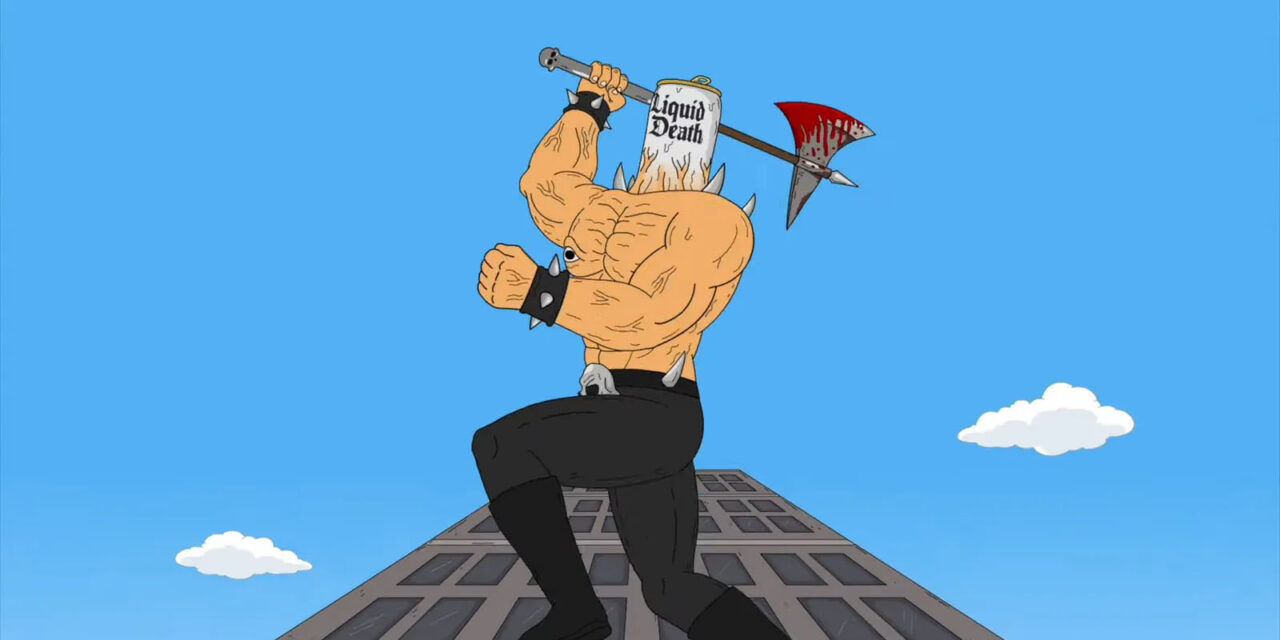An ax-wielding cartoon mascot for Liquid Death. Since its founding, the beverage brand has worked to help consumers “murder” their thirst with irreverent, outré marketing. Retrieved from Liquid Death on August 01, 2024
By Chris Kelly|
Since its founding, Liquid Death has worked to help consumers “murder” their thirst with irreverent, outré marketing. The beverage brand has, among other things, summoned demons, embraced its haters, fought off zombies and pranked taste testers on the way to a $1.4 billion dollar valuation and potential IPO.
As the hydration market continues to expand with new entrants and product innovations, Liquid Death has kept pace, branching out from canned still water to flavored sparkling water, iced tea and electrolyte drink mixes. But it hasn’t stopped the pace of boundary-pushing campaigns, often eschewing pricey media buys for social-first content that is designed for virality. For Liquid Death, the marketing is almost like a third product line next to beverages and merchandise.
“If we consider the ideas and videos that we put out another product, it shifts the way that you approach it,” said Liquid Death’s Vice President of Creative Andy Pearson. “You pay for stuff, not just with money, but with time, likes, following and all of that.”
Pearson, who joined Liquid Death three years ago after stints at agencies McKinney, Deutsch LA and Crispin Porter + Bogusky, spoke with sister publication Marketing Dive about how the brand continues to differentiate itself, how it brings “chaos” to collaboration and why Super Bowl spots are boring.
The following interview has been edited for clarity and brevity.
MARKETING DIVE: The last few years have seen new entrants in hydration and renewed pushes from Big Soda players getting into water and sports beverages. How does this affect how you market and differentiate Liquid Death?
ANDY PEARSON: It really comes from the way that we see and hear people using Liquid Death. Initially, a lot of people were talking about how is it a great replacement for alcohol. Now, we get notes from parents that will email us and say, “Thank you, my high schooler was addicted to energy drinks and now he loves Liquid Death,” which is really cool.
Especially as we’ve expanded into flavored sparkling [water], which is just 20 calories, we hear a lot of people say, “I was drinking cans and cans of soda a day, and now I found this thing that’s just four grams of sugar, and it’s substantially better.”
The pure sugar video that we put out, people really reacted to that pretty strongly. There’s a lot of pent-up demand to have people step back and really look at how things are marketed and the products that are really pushed on us.
I grew up in the ’90s and all the coolest brands were the soda brands. Hopefully we’re changing the way that people think about what they consume and also the way they think about marketing in general. We’re all indicted a little bit in this industry, and so this is our way to have a wider conversation about it in the background.
Liquid Death always seems to have a new video or promotion out, from giving away a fighter jet to teaming with Ozzy Osbourne. Pardon the pun, but how do you balance flooding the zone versus oversaturating the market?
PEARSON: We don’t really buy media, relatively speaking. If you turn on a basketball or football game, you’ll see the same ad like three times because they’re buying media against it to make sure you do that.
We’d rather make something hilarious. We want to be the best thing someone sees that day, and then you can go on about your day. You don’t have to think about Liquid Death again, because we’re not going to keep interrupting the thing that you’re trying to watch. Rather than doing a repeated message, why don’t we use what we’re doing to bring something entertaining to people when we can?
Liquid Death has ramped up brand collaborations, like the corpse paint line with E.l.f. Cosmetics. How do you balance both brands’ needs?
PEARSON: In the middle of the Venn diagram, there’s usually a really interesting, hilarious opportunity. There tends to be a “right” answer. E.l.f. is a good example: When we talked to them, we very quickly came up with [the corpse paint] idea, because that’s what these two brands would get together to do.
For a lot of the brands we work with, they get to open up and expand what they would typically do. For us, we get to go into somewhere where we wouldn’t normally be and inject our form of Liquid Death chaos into whatever corner of pop culture where the brand or celebrity exists. Both of us are getting different things out of it.
The collaborations provide a great new space to bring in satire and parody, reach people and bring some humor to a category that we don’t actively participate in.
Earlier this year, Liquid Death offered an alternative to Super Bowl advertising by auctioning off ad space on its cases. What does that say about what you think about big game advertising and marketing in general?
PEARSON: Every year, people proclaim the doom of the Super Bowl commercial, at least from a creative sense, and then its inventory is already sold out in May. You have these two things that are seemingly opposing happening together. I’ve never wanted to make a Super Bowl spot. I think it’s pretty boring, to be honest. There’s way more interesting things you can do with that money and time.


